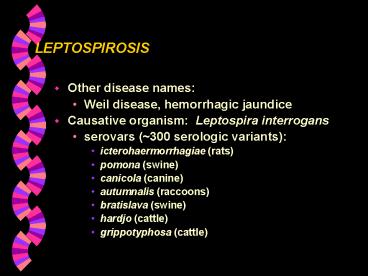LEPTOSPIROSIS - PowerPoint PPT Presentation
1 / 22
Title:
LEPTOSPIROSIS
Description:
spiral-shaped organism with internal flagella. thin, tightly coiled ... in renal tissue (post-mortem) of human patient. LEPTOSPIROSIS. Epidemiologic features ... – PowerPoint PPT presentation
Number of Views:13317
Avg rating:3.0/5.0
Title: LEPTOSPIROSIS
1
LEPTOSPIROSIS
- Other disease names
- Weil disease, hemorrhagic jaundice
- Causative organism Leptospira interrogans
- serovars (300 serologic variants)
- icterohaermorrhagiae (rats)
- pomona (swine)
- canicola (canine)
- autumnalis (raccoons)
- bratislava (swine)
- hardjo (cattle)
- grippotyphosa (cattle)
2
LEPTOSPIROSIS
- Microbiological features
- flexible, gram-negative spirochete
- spiral-shaped organism with internal flagella
- thin, tightly coiled
- unique flexuous-type motility
3
LEPTOSPIROSIS
- EM of Leptospira interrogans (bar0.5?m)
4
LEPTOSPIROSIS
5
LEPTOSPIROSIS
- Microbiological features
- readily cultivated, simple nutrient requirements
- growth in 12 hours at 30ºC, pH 7.4
- distinguishing features
- 3-5 layer outer membrane
- two internal flagella (periplasmic), extending
from each end of the cell affords better
motility in viscous environments than with
external flagella
6
LEPTOSPIROSIS
- Microbiological features
Immunostain organisms and granular forms of
antigen in renal tissue (post-mortem) of human
patient
7
LEPTOSPIROSIS
- Epidemiologic features
- ubiquitous worldwide, especially tropical regions
- vehicle of transmission leptospiruric urine
- reservoir wild and domestic animals
leptospires isolated from gt160 mammalian species
in temperate zone - rodents can shed organisms in urine for lifetime
- domestic animals important source of infection
for humans
8
LEPTOSPIROSIS
- Epidemiologic features
- transmission direct or indirect by contact with
infected urine or urine contaminated soil or
water - direct person-person transmission rare
- soil can remain contaminated for up to two weeks
- has been reported to have been transmitted from
infected mother to infant by breast-feeding - most cases during summer and fall
- Case Fatality Rate low but increases with
advancing age, can be up to 20in individuals
with jaundice and kidney damage
9
LEPTOSPIROSIS
- Clinical features
- incubation period 7-14 days
- biphasic
- commonly involves CNS, kidneys, and liver
- often misdiagnosed as hepatitis or meningitis
- petechial rash, morbilliform or urticarial in
appearance - in 10-30of cases within first 2
days, sometimes pruritic
10
LEPTOSPIROSIS
- Clinical features
- acute leptospiremia phase
- abrupt onset of fever
- severe headache
- muscle pain
- nausea
- jaundice in more severe cases
- symptoms persist for up to 7 days
11
LEPTOSPIROSIS
- Clinical features
- immune leptospiruric phase
- occurs after asymptomatic periods of several days
- antibodies present
- spirochetes no longer present in bloodstream
- leptospiral organisms shed in the urine for
various periods depending on host
12
LEPTOSPIROSIS
- Clinical features
- immune leptospiruric phase
- manifested by
- fever of shorter duration than acute phase
- CNS signs (meningitis)
- more severe form associated with serovar
icterohaemorrhagiae and is called Weils disease
13
LEPTOSPIROSIS
- Clinical features
- mucosa and broken skin most likely route of
infection - multiply in convoluted tubules of kidney (hence
shed in urine) - may persist for weeks to months
14
LEPTOSPIROSIS
- Pathogenesis
- Generalized infection (leptospiremia) upon entry,
but no lesion at site of entry - Host response
- Leptospiricidal
- Humoral antibody formation
- Complement
- Rapid elimination from all except
- Brain slow growth
- Eyes slow growth
- Kidneys shed for weeks to months (urine)
15
LEPTOSPIROSIS
- Pathogenesis
- Virulent strains more resistant to
antibody-complement system - Cell-mediated immunity not effective
- Immunity serotype specific, long-lasting
- Survival likely due to ineffectiveness of
Ab-Complement system in convoluted tubules - Host can be seronegative shedders due to lack of
antigenic stimulation
16
LEPTOSPIROSIS
- Pathogenesis
- Mechanism unresolved not related to toxin
formation (endo-, exo-) - marked contrast between functional impairment and
histologic lesions, suggesting damage primarily
at subcellular level - severe infections cause progressive impairment of
renal and hepatic function but minimal tissue
damage normal function restored when infection
clears - renal failure most common cause of death
17
LEPTOSPIROSIS
- Diagnosis
- demonstration of organisms isolated from blood or
CSF in first 7 days - serology
- rising titers (MAT - microscopic agglutination
test) - IFA
- ELISA
18
LEPTOSPIROSIS
- Prevention and control
- treatment with antibiotics (penicillin and
doxycycline) within first week of signs, not
recommended after acute phase - education
- avoid swimming in potentially contaminated pools
- protective clothing and shoes should be worn when
swimming in areas likely to be contaminated
19
LEPTOSPIROSIS
- Prevention and control
- reduction of prevalence in animal reservoirs
- vaccination of pets and livestock prevents
illness but not necessarily infection and
shedding must contain dominant local strains - rodent control
- vaccination in humans not recommended
- prophylactic antibiotic use (Doxycycline) in
military personnel training in certain tropical
areas
20
LEPTOSPIROSIS
- Recent outbreak
- outbreak of acute febrile illness among athletes
from 44 states and 7 countries among 110 of 1194
participants (9) in triathlons that took place
in Springfield, IL (6/21/98) and Madison, WI
(7/5/98) - Leptospirosis cause of illness in participants
and other persons exposed to Lake Springfield - high titers to serovars grippotyphosa,
bratislava, djasiman
21
LEPTOSPIROSIS
- Recent outbreak
- individuals only participating in Madison event
had milder illness, no serologic evidence of
leptospirosis - attack rate 11 IL only 5WI only 7both
- all 23 hospitalized participated in IL triathlon
22
LEPTOSPIROSIS

